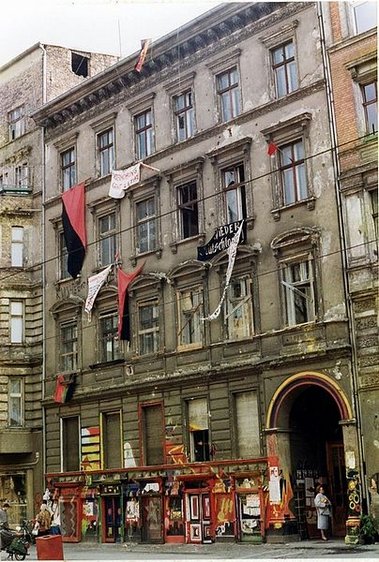Squatted houses in Berlin – What remains?
Project information
submitted by
Kirsten Angermann, Ulrike Kuch, Franka Fetzer
Co-Authors
Yolanda Albrecht, Inken Ankermann, Anna Babick, Kerstin Baier, Nathalie Berrier, Hans Böhm, Julia Dürkoop, Carolin Fust, Jasper Hanssen, Zoe Kesselring, Friederike Müller, Luis Naber, Lena Paffrath, Hanna Steckl, Lea Stein, Leonhard Zumbusch, Linus Baumhove, Lena Beckmann, Simon Doms, Victoria Egle, Anastasia Eppinger, Alisa Fainberg, Stefan Haal, Leonhard Kaiser, Annika Knapp, Olivier Mayette, Leon Mones, Gerrit Müller-Scheeßel, Emilia Natalis, Viktoria Renz, Nico Schmitt, Benjamin Schumacher, Andreas Stanzel
Mentors
Dr. des. Kirsten Angermann, Dr. Ulrike Kuch, Franka Fetzer B.Sc.
Faculty:
Architecture and Urbanism,
Art and Design,
Media,
Bauhaus.Module
Degree programme:
Architecture (Bachelor of Science (B.Sc.)),
Architecture (Master of Science (M.Sc.)),
Urban Planning (Bachelor of Science (B.Sc.)),
Media Studies (Master of Arts (M.A.)),
Media Art and Design (Bachelor of Fine Arts (B.F.A.))
Type of project presentation
Exhibition
Semester
Summer semester 2023
- Geschwister-Scholl-Straße 8 - Hauptgebäude / Main Building
(Raum 105)
Participation in the Bauhaus.Modules
Links
https://www.uni-weimar.de/de/arc...
https://www.uni-weimar.de/de/arc...
Contributors:
Landesdenkmalamt Berlin, Archiv der Jugendkulturen Berlin
Project description
Squatted houses and the associated subcultures are an essential facet of the identity of the city of Berlin. Since the 1970s, squatting was established as a form of (political) protest and an experimental field for ways of living together. Some squatted houses were eventually legalized, many others were and are being evicted. Thus, piece by piece, buildings, spaces, and milieus that belong to the image of the city of Berlin are disappearing. The buildings themselves, however, remain and continue to be used.
But what remains of the squatted houses? In the seminar, we addressed this central question and discussed further questions using case studies:
• What processes of appropriation of the houses and apartments took place? Do any forms of documentation or traces exist?
• What insights can be gained from the appropriations for the design of a processual architecture?
• Who are the actors in the discourse on the legacy of squatted houses?
• What influence do and did the legal protection of squatted houses as monuments have on their preservation?
• Should squatted houses be monuments because of their squatting history?
The seminar was organized as part of the Fellowship Forschungswerkstatt "What remains? Occupied houses as (im)material heritage and case studies for processual design". First results, prepared as a zine, as well as relics, photos and analyses of the buildings will be exhibited.

